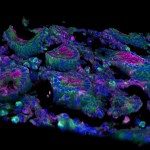Link to Pubmed [PMID] – 14963145
J. Virol. 2004 Mar;78(5):2472-7
It had been suggested that during integration of spumaretroviruses (foamy viruses) the right (U5) end of the cDNA is processed, while the left (U3) remains uncleaved. We confirmed this hypothesis by sequencing two-long terminal repeat (LTR) circle junctions of unintegrated DNA. Based on an infectious foamy virus molecular clone, a set of constructs harboring mutations at the 5′ end of the U3 region in the 3′ LTR was analyzed for particle export, reverse transcription, and replication. Following transient transfection some mutants were severely impaired in generating infectious virus, while others replicated almost like the wild type. The replication competence of the mutants was unrelated to the cleavability of the newly created U3 end. This became obvious with two mutants both belonging to the high-titer type. One mutant containing a dinucleotide artificially transferred from the right to the left end was trimmed upon integration, while another one with an unrelated dinucleotide in that place was not. The latter construct in particular showed that the canonical TG motif at the beginning of the provirus is not essential for foamy virus integration.
